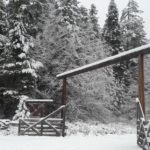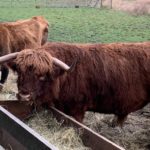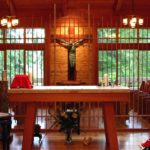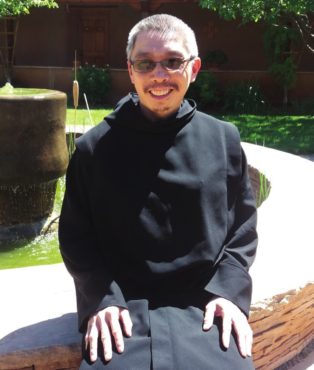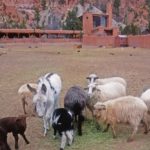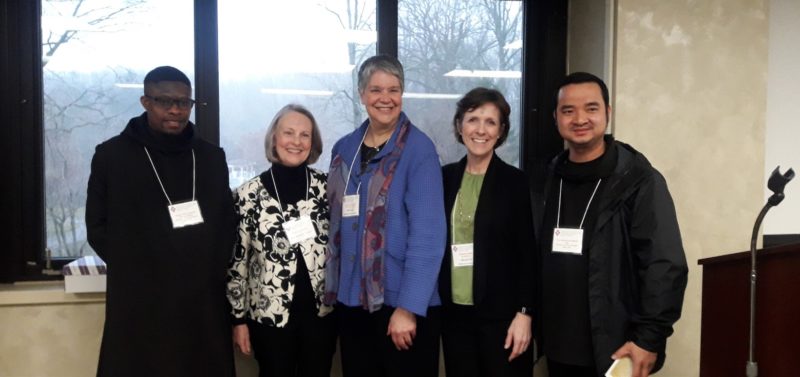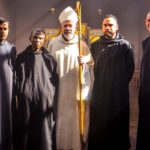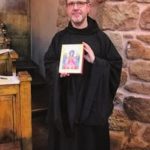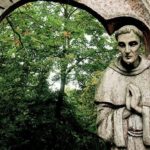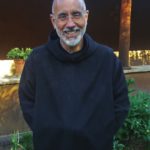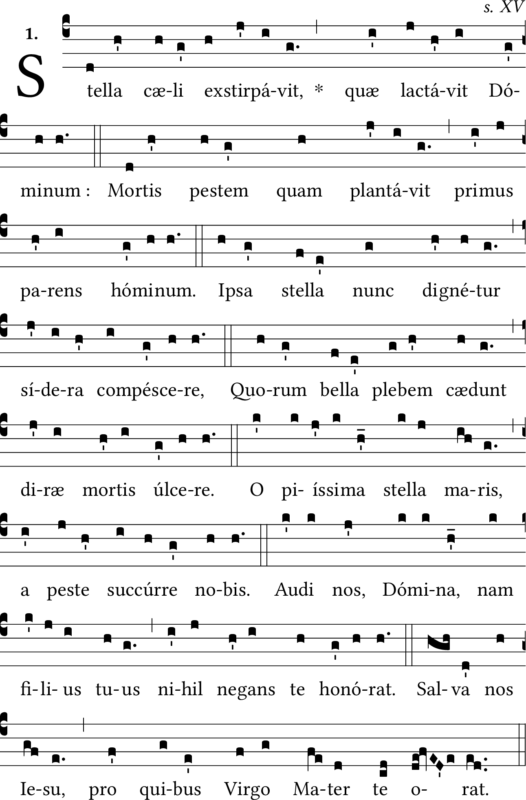 PO Box 270, Abiquiu, NM 87510 • Telephone: 575-613-4233 • www.christdesert.org
PO Box 270, Abiquiu, NM 87510 • Telephone: 575-613-4233 • www.christdesert.org
JOURNEY TO GOD
Many people ask today: where is our Church and Catholic culture headed? The replies to the question are not always positive or encouraging. There may be many reasons to agree with the negative assessment, but as Christians and Catholics, monks hold dear a saying of Saint Benedict contained in his
“Rule for Monasteries,” that we strive to follow: De dei misericordia numquam desperare, that is, “Never to despair of God’s mercy.” This comes from the fourth chapter of the Rule, on the “Instruments (or Tools) of Good Works.”
The poet Henry Wadsworth Longfellow wrote, “Into each life some rain must fall.” That means we are all confronted from time to time or very regularly with the fact that there are realities over which we have little or no control and we must learn to accept them. The famous “Serenity Prayer” expresses it in terms of being granted the serenity “to accept the things I cannot change, courage to change the things I can, and wisdom to know the difference.” Hopefully, being able to do that carries with it some guarantee of serenity or calm. I believe this to be the case, and that it is rooted in trust in God and His grace, acting in human lives.
Returning to the “Instruments of Good Works” from the Rule of Saint Benedict, monks are encouraged “never to despair of God’s mercy,” whatever the situation we might face. Along these lines, Saint Paul heard the following words from God: “My grace is sufficient for you, for my power is made perfect in weakness” (2 Corinthians 12:9), words that should comfort us all as well.
The best way at our disposal to respond to the Gospel message of Jesus Christ is by the transformation of the inner person, through forming good habits and even taking delight in virtue. It is an ongoing work, though, not simply a once and for all attempt.
This ties in directly to the vow of stability which Benedictines profess, implying that we stick to the task at hand and adopt a way of living that leads to habits that are healthy and life-giving.
A Benedictine is ideally a person who seeks the conversion of his or her character in the context of community life. This is contrary to a spirit of narcissism, defined as self-centeredness arising from ignoring a healthy distinguishing of self from external reality. Said another way, narcissism is excessive or extreme preoccupation with self and a lack of concern or taking into account other human beings.
The healthy person, in community or not, learns from others, looking to living models and seeking to be like those who are virtuous and worthy of imitation. In the Benedictine context, the existence of both the young and old opens up the possibility of finding role models in those who are more experienced in the monastic life, who have trodden the path for many decades and who are guideposts for the journey to God. Often, such role models need say nothing, because their way of being and actions speak volumes to those who are astute enough to pick up what is valuable in the seniors. We were taught as youngsters, “actions speak louder than words,” and the saying is still true. Another adage that is applicable here is this: “better to be than to seem to be.”
A life lived in common, such as in a monastery, is a powerful witness in the world today, that communion, in contrast to alienation, is still possible. When people come together to share common aspirations, hold goods in common and extend care to others, then something of great value emerges, both for the members of the community and those outside of it. That is the basic model of the Benedictine monastic journey as well.
Great advice from ancient philosophy is this: know thyself. Such knowledge will likely take a lifetime, but those set on the path of self-knowledge are better equipped to move from self-seeking to self-giving, from vice to virtue, from sharing in Christ’s sufferings, in order to be a partaker in Christ’s glory (see 1 Peter 4:13). In the process, such persons, and we among them hopefully, can be a source of light, hope and joy for all and at all times.
Whatever the future holds for us, individually and as Church, is in God’s hands. We must trust in Divine Providence and do our part as well to promote a culture of life and hope, rooted in Jesus Christ. ✠
May the Lord bless you and keep you!
SHAW ISLAND
By Father Jeffery
Approaching Shaw Island from the coast of Washington State is something of a thrill the first time you do it. Shaw is one of the San Juan group, not very far from Seattle. It is one of the smaller islands and it is densely wooded. The dark green of the trees is the first thing you notice as you approach. I was on my way to spend a month with the community of Benedictine Nuns at St Scholastica Monastery. I haven’t been in the United States for much more than two years, living in New Mexico. I recently changed my Stability from my monastery in South Africa to Christ in the Desert Monastery. It is fascinating to get to know a country
as vast as the USA with all its variety. The nuns were without a chaplain for a month and I jumped at the chance to see a new community and a new part of the country.
Religious women have played a part in the life of the island for many years. Franciscan sisters actually ran the ferry dock and the only store on the island some years back. Now there are two communities of women – the Monastery of Benedictine Nuns and the Retreat House of the Mercy Sisters. I was to get to know both communities. Both communities are small, with six and four members respectively. My duties were to say Mass and preach a homily daily.
I had expected to do lots of walking and exploring but the weather was pretty dismal. Some locals claimed that it was the coldest and wettest January in twenty years. Mostly it was grey skies and rain with some sunshine now and then. Trees and water! That’s what I think of when I look back on my time there. Apart from the surrounding sea, and one is never far from the edge of it, the forest trills with rivulets and streams. The sound of running water still runs beautifully in my head. And there are pools of water everywhere. At first, I found the forest impressive but slightly menacing. Under a grey sky you can’t see far into the forest before it becomes gloomy. But this totally changes when there is sun. The rays of sun cut through the tops of trees and you can see one leafy glade after another in patches of gold and green. Enchanting!
What a place for a retreat. I took two trips to other islands as well, to Orcas and San Juan with their lovely little tourist villages and more open spaces than Shaw. One memory that stands out is standing at the beach not far from Friday Harbor on San Juan. There was a bracingly cold wind coming off the sea, there were piles of driftwood at the highwater mark, the long, long beach was completely deserted and in the misty distance was the edge of Canada.
Relatively few people live on Shaw and one is very aware of big money and private property. There is one store, a community center (hall, fire dept. etc.), a library and a little red schoolhouse. The nuns play their part in the community with some representation at community meetings and as volunteers at the library.
But, of course, it is the life of prayer and community that marks the lives of both religious communities. The nuns’ chapel is a gem, designed by a friend of theirs in the Japanese style. This style is echoed in the several gateways to their property – a Zen-like simplicity and natural wood colors. The grill between the nuns’ part of the chapel and the rest is partly done in bamboo. Their property is big and they run a farm with a variety of animals – cattle (Scottish Highlanders and two Jerseys), sheep (fat Cotswold butterballs in grey wool), llamas and alpacas, chickens for eggs, a koi pond, herb gardens for a variety of herbal products (glorious mustards). The nuns are no longer young, and the farming is looked after by young women interns. The hospitality from both communities was heartwarming.
The Mercy Sisters have a Retreat House not far from the monastery. I joined them twice for a meal and prayer. A small chapel with large windows along one side of the house looked out onto a cove. There was a beach, the cove was fringed with trees, the evening sun was glinting on the water and sea birds were swooping down and skimming the surface of the water. Where was I to focus my prayer? To the Blessed Sacrament in the monstrance or to Nature’s own liturgy? I was caught between two beauties.✠
MONKS CORNER
What is your name and age?
Br. Jude Vo, and I am 40 years old.
How long have you been a monk at MCD?
I have been a monk at the monastery for 11 years. I was at the Congregation of Mother Coredemptrix in Carthage, Missouri for three years prior to joining the Monastery of Christ in the Desert. It is now known as The Congregation of the Mother of the Redeemer (Vietnamese: Dòng Mẹ Chúa Cứu Chuộc; Latin: Congregatio Redemptoris Matris, abbreviated CRM). It is a religious institute within the Roman Catholic Church that is based in Vietnam and hosts a large Vietnamese membership.
What were some of your challenges as a monk at MCD during your time here?
My biggest challenge of late is managing the kitchen and pantry for our monastery. Dealing with all the brothers canbe challenging.
What changes have you witnessed during your time here at MCD?
Leadership has changed at our monastery. I have also witnessed the changes in vocations. When I came first 2009, there were about 20 monks. Within the past two years, we reached larger numbers in the community. Now, we are right at 35 monks. I like lower numbers because we can be more attentive to each other.
Who is your favorite saint, and why?
St. Jude is my favorite saint and my patron saint for monastic life. Originally, St. Anthony of Padua was my baptismal namesake. St. Anthony is the saint who intercedes on your behalf for lost things. St. Jude intercedes for lost causes. I consider myself wellcovered by both these saints.✠
FEED MY SHEEP
by Brother Chrysostom
When they had finished eating, Jesus said to Simon Peter, “Simon son of John, do you love me more than these?” “Yes, Lord,” he said, “you know that I love you.” Jesus said, “Feed my lambs.” Again Jesus said, “Simon son of John, do you love me?” He answered, “Yes, Lord, you know that I love you.” Jesus said, “Take care of my sheep.” The third time he said to him, “Simon son of John, do you love me?” Peter was hurt because Jesus asked him the third time, “Do you love me?” He said, “Lord, you know all things; you know that I love you.” Jesus said, “Feed my sheep” (Jn 21:15-17).
This is a familiar passage to many of you, yet there is still so much meaning within it yet to discover. I am a wrangler, a person in charge of horses or other livestock on a ranch. In my particular case it means nineteen Navajo-Churro sheep, two donkeys, and thirteen Bantam chickens, all within the cloister of our monastery. We have sheep for the wool, which we will spin (the spun wool will be used for in-house weaving, the balance we will sell). Donkeys are fine anti-predator protectors of the sheep (I have seen plenty of donkeys used for that purpose at Mt. Saviour Monastery in Elmira, New York). And, the chickens are for fresh eggs (you wouldn’t imagine how many eggs we consume in a week)!
Growing up on the South Side of Chicago, my closest proximity to sheep was the regular lamb patties for dinner and the leg of lamb for Easter that my mother would cook lovingly and dutifully for me and my father. So, when I offered to help Abbot Christian with our growing flock, I was unaware of the wonderful blessings that lay in store for me. One of my favorite Old Testament prophets, Jeremiah, comes to mind: “For I know the plans I have for you, declares the LORD, plans to prosper you and not to harm you, plans to give you hope and a future.” (Je 29:11). Boy, how true that was for me! Thanks to my beautiful maternal grandparents, Arthur and Sarah, and their rural homestead in St. Anne, Illinois, yards from the Kankakee River, I and my citified younger cousins Charlene, Claudine, and Christine received a wonderful education about farming and country living. We spent many, many halcyon summer days planting and tending a small plot along with geese and chickens. Although our grandparents gave us an excellent introduction to animal husbandry, sheep are altogether different creatures.
I feed the sheep twice a day, directly after Mass around 7am and an hour before lectio divina around 3pm. Fred Rogers was an early childhood hero, so I took a page out of his playbook on consistency. When I feed the sheep I wear the same things and approach them the same way every day. The morning attire that I change into (without song or the tossing of blue laced sneakers) consists of blue jeans, a gray work habit, a bright red ski cap, glasses, and yellow lambskin gloves. The afternoon attire differs slightly, no ski cap because it has warmed up considerably by then, with a safari hat and sunglasses. Zoe, the mother donkey, brays loudly every time I approach the field as I leave my cell; donkeys and sheep have good eyesight. Matty, her daughter, and Zoe greet me at the gate to their pasture. The nineteen sheep in the meantime are clustering and roving, waiting for me to produce food. Their bahs and bleeps create a cacophony which is not quite like the chanting of my brother monks, but sounds soothing. I know Gloria, a creamy white sheep, who has chutzpah and, unlike her skittish fellow sheep, is not afraid to get close to me. Feeding is pretty simple, but you have to be consistent. Hay goes into mangers and some spots on the ground to give Wally, our runt lamb, ample opportunity to eat; grain supplement is put into bowls placed strategically in the pasture that is about as complex as the job gets.
I remember a priest telling me a story about how difficult it is to employ the sheep metaphor in the Gospels in places where there are no sheep, like Alaska. Although, unlike most people who would take umbrage with the connection, I have come to see rather quickly that we are like sheep, which requires a longer treatment, maybe even a book! I will offer just a few common characteristics: an ability to overcome fear of someone who provides one’s daily sustenance in order to nibble on any morsel of food; no desire to move without nineteen of one’s closest family and friends; and the expert skill of looking another squarely in the eyes without once betraying that one has no idea of what the other is saying. I enjoy feeding the sheep and I hope to continue to do that for as long as possible. However, I know that the revival of our beekeeping efforts is on the horizon and I hope to be the next pollinator at the monastery. We consume a lot
of honey at the monastery; it would be great to produce our own, especially to help those brothers who suffer from allergies. It is said that consuming locally produced honey can help develop resistance to local pollen allergies. One thing that I have discovered as a wrangler: how quickly you come to love someone or something you feed. Maybe that is the hidden meaning in Jesus’ exhortation to Saint Peter. Not that the sheep only need feeding, but that they need loving, too. When I miss a feeding, usually because of a town trip, I miss them. And, I know that they miss me, too. Zoe’s loud Tarzan-like braying always lets me know that she needs me to resume my duty of feeding (and loving) her. Don’t we all need to know and be reminded that we are loved and that the command to“Feed my sheep” is for all of us? ✠
- Br Chrysostom
- Matty and Sheep
- Zoe
- Gloria
END OF LIFE CONFERENCE
Fortunately, before the pandemic, our Prior Bonaventure and Br. Isidore were able to travel in order to attend a conference funded by the Retirement Fund for Religious and sponsored by the National Religious Retirement Office. The conference held in Marriotsville, Maryland from February 24 through 27, entitled “A Gifted Journey: Accompanying a Person Through the Dying Experience” coached our brothers on how to be a support-person during this end of life process. The conference served multiple purposes. Our two monks were able to absorb some of the many opportunities and challenges support-people experience in thoughtful accompaniment of a person through the end of his or her life. Additionally, the monks with the other participants (40 or more sisters and nuns; our monks were the only male religious in attendance!), benefited from a forum to discuss physical, social, ethical, and spiritual care perspectives for those going through the dying experience. Conference attendees explored Catholic theological, cultural, and contemporary views of death, and the gift of being present with and to those who are dying. A final purpose of the conference provided practical skills to facilitate communication with and the support of those approaching the end of life.
Each day of the three-day conference began with Mass at 7:30am, followed by a scheduled program and concluded with a time for social interaction at 7:30pm. The conference was blessed to have two experienced presenters. Susan Belanger, PhD, MA, RN, NEA-BC, the main presenter at the conference, is the Senior Vice President and System Ethicist for Covenant Health, a Catholic Healthcare Organization located in Tewksbury, Massachusetts. Her passion in ethics is helping patients to die well through value-based end-of-life decision making. The other presenter, Elizabeth Collins, BA, BSN, MA, is a registered nurse
and serves as the Clinical Care Coordinator for the Sisters of Providence in St. Mary-of-the-Woods, Indiana. As a nurse, she is fervent about the many ways we are called to live th egift of life well until we die. ✠
PROFESSIONS
Dom Joseph Kuchta Chylinski, O.S.B., professed solemn vows on the Feast of the Presentation of the Lord at the monastery church on February 2, 2020. Dom Joseph entered monastic life in 2014. Over the past six years he has served as deputy librarian, chief sacristan, Master of Liturgical Ceremonies, and a caregiver to two of our older monks. He was raised in a spiritual nurturing family, who claim two canonized religious who are well known in his native Poland. The 17th century Saint Andrew Bobola, S.J. hails from his paternal side of the family, and the 18th century Blessed Raphael Chylinski, O.F.M., Conventual hails from his maternal side of the family. Br. Faith, Br. Efren, Fr. Seraphin, and Fr. Columba professed simple vows on the Feast of St Scholastica on February 10, 2020. Fr. Zachary entered the novitiate on March 20, 2020. ✠
- Fr. Seraphim, Br. Faith, Abbot Christian, Br. Efren, Fr. Columa
- Father Joseph
- St. Andrew Bobola SJ
- Blessed Raphael Chylinski, O.F.M
- Father Zachary
REMEMBER THE GIFT OF A BEQUEST
In the past we have received wonderful bequests from deceased friends who understood well the process of including us in their wills and had their wishes towards the monastery executed after their passing. We remember them daily in our prayers. If you are interested in leaving a gift that will support
our life of prayer, we ask that you consult your wealth manager or estate planner. Or, alternatively, you can simply form a bequest within your will in the language given below:
I give, devise, and bequeath to the Monastery of Christ in the Desert, 1305 Forest Service Road 151, Abiquiu, NM 87510-0270, a corporation organized and existing under the laws of the State of New Mexico… (state here the amount of money or description of the property willed).
For wills, bequests and estate planning, our legal name is: Monastery of Christ in the Desert, Inc.
Carefully planning your gifts can result in major benefits to you, to your family and your charitable goals. Giving securities is just one of many ways available for effective estate and financial planning. With regard to any financial decision, we encourage you to always seek sound financial advice.
Know that our prayers will be the gift we offer in return for your generous bequest, prayers that support you and your loved ones. “Beloved, I pray that all may go well with you and that you may be in good health, as it goes well with yoursoul” (3 John 1: 2). ✠
During this challenging time of sickness, we pray to God through the intercession of our Blessed Mother for the well- being of those who are ill and the health of all.





